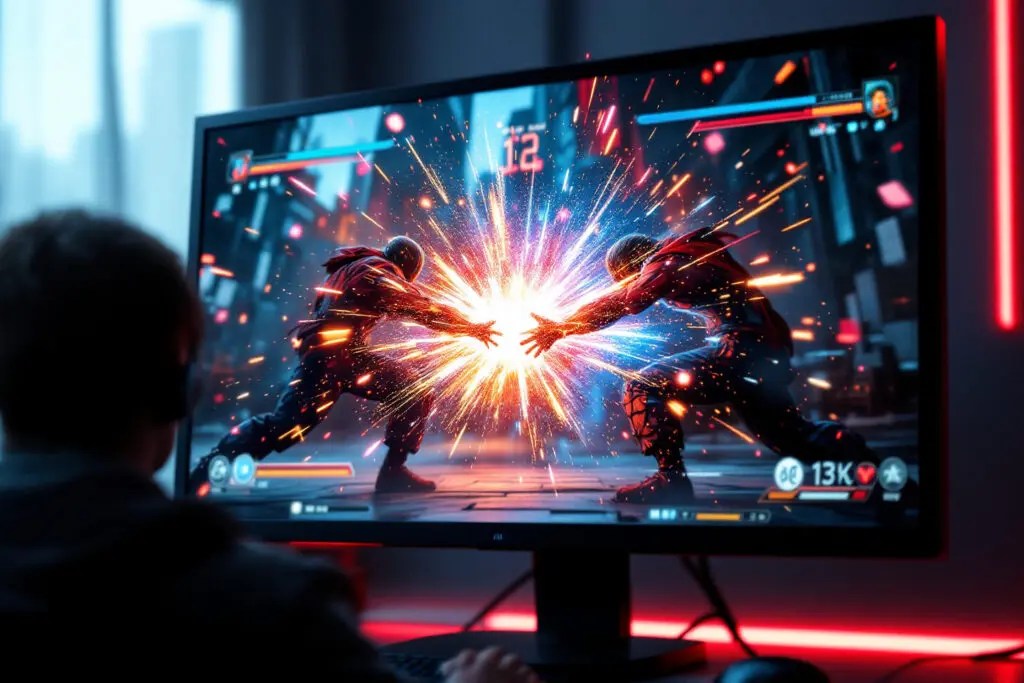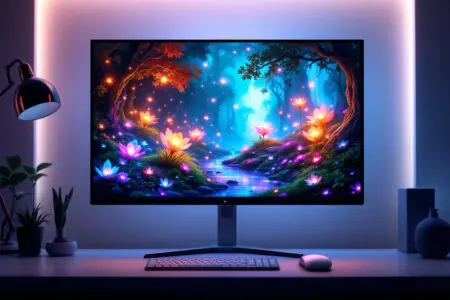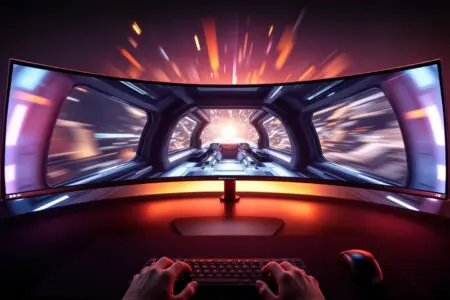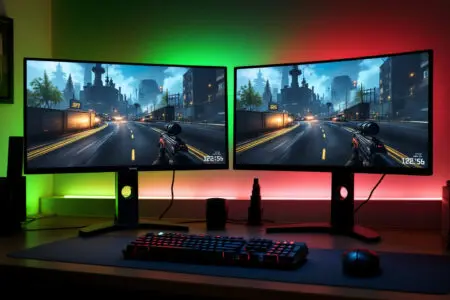I’ll never forget the first time my monitor flat-out betrayed me. I was a teenager, holed up in my room, bathed in the glow of my CRT, playing Counter-Strike. My new graphics card was a beast, and the game was running buttery smooth. I rounded a corner, ready to ambush an opponent, and then it happened. My entire screen ripped in half. For a split second, a jagged, ugly line separated the top and bottom of the world. My shot went wild. I was dead.
I later found out that hideous visual glitch was called screen tearing. For years, I just accepted it. It was just a frustrating quirk of PC gaming, or so I thought. Then, a technology came along and changed everything. So, what is AMD FreeSync? It’s the cure for screen tearing. It’s the technology that finally gets your graphics card and monitor to speak the same language. Once you see it in action, you’ll never go back.
More in Monitors Category
What is The Best Resolution for Gaming
Key Takeaways
- Perfectly Smooth Gaming: AMD FreeSync syncs your monitor’s refresh rate directly to your graphics card’s frame rate. The result is the complete elimination of screen tearing and stuttering.
- An Open Standard for All: Because it’s built on the VESA Adaptive-Sync standard, FreeSync monitors are everywhere and are typically much more affordable than displays using proprietary hardware.
- Three Tiers, Three Levels of Performance: FreeSync is available in three flavors: the standard FreeSync, FreeSync Premium, and FreeSync Premium Pro. Each level adds new capabilities, like mandatory high refresh rates, Low Framerate Compensation (LFC), and best-in-class HDR support.
- Not Just for AMD GPUs: You don’t have to own a Radeon card. Newer NVIDIA and even Intel graphics cards can use FreeSync on compatible monitors, making it a smart choice for any PC gamer.
- Better Than Just Games: The benefits of a variable refresh rate go beyond gaming. You’ll notice smoother video playback, cleaner web scrolling, and a more fluid experience across your entire desktop.
Does Your Game Ever Look Like It’s Tearing Apart?
That moment in Counter-Strike wasn’t a fluke. It happened constantly. In racing games, the beautiful world would shear in two on a tight corner. In shooters, a quick turn would rip the image right when I needed to see clearly. It felt like the game world itself was breaking. For the longest time, the only fix was V-Sync, a “solution” that brought a whole new host of problems. The real issue was a fundamental communication breakdown between my powerful GPU and my monitor. They were operating on different schedules, and the on-screen result was pure chaos.
So, What’s Really Going On During a Screen Tear?
Think about the two main components in this relationship: your graphics card (GPU) and your monitor. The GPU is the workhorse, furiously rendering frame after frame of your game as fast as humanly possible. The monitor is the display, showing you those frames one after another to create the illusion of smooth motion.
The problem is all about timing. A monitor has a fixed refresh rate, measured in Hertz (Hz). A 60Hz monitor redraws the screen 60 times per second. No more, no less. It’s on a strict schedule. Your GPU, on the other hand, outputs frames at a variable frame rate (FPS). In a game, your FPS can bounce all over the place, from 120 FPS in a quiet moment to below 60 FPS when a massive explosion rocks the screen.
Screen tearing is what happens when the monitor starts to display a new frame while it’s still in the middle of drawing the last one. Your GPU has already finished the next picture and sent it along, but the monitor is only halfway done with its current refresh cycle. What you see is the top half of the old frame and the bottom half of the new one, sliced by a jarring horizontal line. It’s a clear signal that your hardware is out of sync.
How Does AMD FreeSync Fix This Mess?
This is where the magic happens. Instead of making the GPU wait or letting the monitor tear the image, FreeSync flips the script entirely. It tells the monitor to ditch its rigid, fixed refresh rate. It introduces a revolutionary concept: a Variable Refresh Rate (VRR).
Let’s Break Down Refresh Rates vs. Frame Rates
Picture a factory assembly line. The conveyor belt—your monitor’s refresh rate—moves at one constant speed. A worker—your GPU—places finished products—game frames—on the belt. If the worker is faster than the belt, products pile up and make a mess. If the worker is too slow, you get awkward empty spaces on the belt. This is the old way of doing things, leading to either screen tearing (V-Sync off) or stuttering (V-Sync on).
AMD FreeSync rebuilds the entire assembly line. Now, the conveyor belt waits for the worker. The moment a new product is ready, the belt moves just enough to accept it. The belt’s speed perfectly mirrors the worker’s output. No mess. No gaps. Just a perfectly smooth, efficient flow.
So, What’s the Secret Sauce?
It’s simple, really. FreeSync lets the monitor give up its role as the boss. It no longer refreshes 60 or 144 times a second just because the clock tells it to. Instead, it waits. It sits patiently until the graphics card has a fully rendered frame ready to go. Only when that complete frame arrives does the monitor refresh its screen to show it to you.
Your game is running at 87 FPS? Your monitor refreshes at 87Hz. It drops to 54 FPS? Your monitor instantly adjusts to 54Hz. This perfect 1:1 sync means a new frame from the GPU is always met with a fresh display cycle on the monitor. The result is no more tearing. Ever. It’s physically impossible. On top of that, the stutter and input lag from older solutions are gone. This is the seamless, fluid motion you were always supposed to see.
Is This Just a Fancy Name for V-Sync?
Not even close. It’s a fair question, since both aim to kill screen tearing. But they approach the problem in completely different ways. For years, V-Sync was the only tool in the box, but it was a clumsy hammer that often created more issues than it fixed.
What We Had to Suffer Through Before FreeSync
V-Sync, or Vertical Sync, was the old way. Turn it on, and it puts a leash on your graphics card. It forces the GPU to wait until the monitor finishes its current refresh cycle before sending a new frame. It caps your frame rate to your monitor’s refresh rate, like 60 FPS on a 60Hz monitor. This does stop tearing, but you pay a heavy price for it.
Why V-Sync Was Never the Answer
The number one problem with V-Sync is input lag. Since your GPU is often holding onto a finished frame, waiting for the monitor to give it the green light, a delay builds up. It’s a tiny delay, but it’s the gap between when you move your mouse and when you see that movement on screen. In fast-paced games, that lag will get you killed.
The second problem is a horrible stutter. What if your GPU’s frame rate dips even slightly below the monitor’s refresh rate? If you drop to just 59 FPS on a 60Hz monitor, V-Sync can panic and display the previous frame again to maintain sync. The result is your effective frame rate getting chopped down to 30 FPS for a moment. This causes a massive, jarring stutter that feels way worse than the tearing it was meant to fix. FreeSync solves both problems, killing tears without adding lag or stutter.
I See Different “Tiers” of FreeSync. What’s the Difference?
As the tech has gotten better, AMD rolled out a tier system to make it clear what kind of performance you can expect. It’s a way to guarantee a certain level of quality beyond just the basic tear-free experience.
FreeSync: The Original and Still Great
This is the baseline. Any monitor with the “FreeSync” sticker on it promises a tear-free, low-latency experience. It works over both HDMI and DisplayPort and is the foundation for the other tiers. If you’re on a budget and just want to get rid of screen tearing for good, this is a fantastic place to start.
What Makes FreeSync Premium So Much Better?
FreeSync Premium is a huge step up and the sweet spot for most serious gamers. To get this badge, a monitor has to do two extra things:
- Go Fast: It must support a refresh rate of at least 120Hz at a minimum of 1080p resolution. This guarantees a high-performance, super-fluid baseline.
- Handle the Dips with LFC: This is the real game-changer. It stands for Low Framerate Compensation. Every monitor has a VRR range, like 48-144Hz. If your game’s FPS drops below that 48 FPS minimum, LFC kicks in and saves the day. It cleverly repeats frames to push the frequency back into the monitor’s sweet spot (so 40 FPS becomes 80Hz). This prevents the horrible stutter that would otherwise happen, keeping things smooth even when your PC is struggling.
Is FreeSync Premium Pro Worth the Extra Cash?
This is the top dog, what used to be called FreeSync 2 HDR. As that name suggests, Premium Pro is all about delivering a phenomenal High Dynamic Range (HDR) experience. It has all the perks of the Premium tier but adds strict standards for color accuracy and brightness. It ensures HDR content looks exactly as intended and guarantees low latency whether you’re in SDR or HDR mode. If you’re an HDR nut who demands the absolute best picture quality, this is the tier for you.
I Have an NVIDIA Card. Is FreeSync Off-Limits?
For a long time, the answer was yes. The world was split in two. AMD had FreeSync, and NVIDIA had its own proprietary, more expensive G-Sync. You had to pick a side. Thankfully, those days are over.
The Plot Twist: NVIDIA Opens the Door
In a huge move back in 2019, NVIDIA decided to let its cards support the open VESA Adaptive-Sync standard. That’s the very same tech that FreeSync is built on. Suddenly, millions of NVIDIA GeForce owners could tap into the huge, affordable ecosystem of FreeSync monitors. NVIDIA calls their certified monitors “G-Sync Compatible,” but the feature can often be enabled on uncertified displays, too.
How Can I Get It to Work?
It’s incredibly simple. You need an NVIDIA GeForce 10-series card or anything newer. First, you have to connect your monitor with a DisplayPort cable. Then, make sure you have the latest NVIDIA drivers. From there, just open the NVIDIA Control Panel, find the “Set up G-SYNC” tab, and flick the switch to enable it. A single checkbox opens up a world of smooth, tear-free gaming.
What Do I Need to Get Started with FreeSync?
Jumping in is easy, but you need to make sure your hardware is on the same page. It’s a quick checklist to unlock a new level of smooth gameplay.
- A FreeSync Monitor: This is the first step. Look for the AMD FreeSync, FreeSync Premium, or Premium Pro logo on the box. AMD keeps an official list of all certified monitors on their website, which is a great place to double-check.
- A Compatible GPU: Of course, any modern AMD Radeon card is good to go. For the NVIDIA crowd, you’ll need a GeForce GTX 10-series, 16-series, or any RTX card (20, 30, or 40-series). Intel’s new Arc GPUs also support the standard from day one.
- The Right Connection: While FreeSync can work over HDMI on some monitors, DisplayPort is the way to go. It offers more bandwidth and is the most reliable choice, especially for high refresh rates.
- Up-to-Date Drivers: Grab the latest drivers for your graphics card. Once they’re installed, you have to do two things: enable FreeSync in your GPU’s control panel, and then turn it on in your monitor’s own settings menu. It’s usually a simple toggle in the on-screen menu.
So, Is FreeSync Actually as Good as People Say?
Yes. One hundred percent, yes.
I remember playing The Witcher 3 for the first time on my new FreeSync Premium monitor. I had put up with stutters and tears for so long on my old 60Hz screen that I just thought it was normal. This was a revelation. Riding Roach through the fields of Velen, everything was just… perfect. The trees, the grass, the distant mountains—it was all completely fluid. No tearing when I spun around, no stuttering when a griffin attacked. It wasn’t just smoother; it was more immersive. I was finally in the game, not just watching it through a screen that was fighting to keep up.
But Will It Make Me a Better Gamer?
It’s not a magic aimbot, but it absolutely gives you an edge. The lower input lag means your actions hit the screen faster. The lack of tearing and stutter means there are no visual distractions to pull your eyes away from the target. In a game where every millisecond counts, a perfectly clean and fluid image lets you track opponents more easily and react quicker. It lets your skill shine through, unhindered by your hardware.
Is It Just for Sweaty, Hardcore Gamers?
Absolutely not. This is what surprised me the most. I notice the difference even when I’m just working. Scrolling a long website is smoother. Panning across a high-res photo feels more natural. Even watching a movie looks better, with no judder during sweeping landscape shots. It’s a massive quality-of-life improvement that makes everything you do on your computer feel just a little bit better.
What’s the Catch? There Has to Be a Downside.
Look, no tech is perfect. But the “downsides” to FreeSync are tiny and have mostly been ironed out over the years.
The “Variable” Part Can Be Tricky
Remember that FreeSync works within a certain range, like 48Hz to 144Hz. If your game’s FPS drops below that 48 minimum, FreeSync turns off. This is why FreeSync Premium with LFC is so important—it effectively erases that minimum boundary, keeping your game smooth no matter what.
What About Ghosting or Overshoot?
In the early days, some cheaper FreeSync monitors had issues with “ghosting” (smeary trails behind moving objects). This was because the display panels weren’t fast enough to handle the changing refresh rates. Today, panels are much faster, and the certification process is much stricter. As long as you stick to a well-reviewed, certified monitor, this is a non-issue. The technology is based on the royalty-free VESA Adaptive-Sync standard, which has pushed the whole industry forward.
The Final Verdict: It’s a Must-Have
In the world of PC building, it’s easy to get lost chasing bigger numbers. More cores, higher clock speeds, more VRAM. But AMD FreeSync offers something you can actually feel. It’s not about raw power; it’s about the quality of the experience. It fixes a fundamental problem that has annoyed gamers for decades, and it does it without demanding a huge premium.
It turns your gaming experience from something that can be choppy and distracting into an adventure that is perfectly fluid and immersive. If you’re a competitive player, it’s a critical tool. If you’re a casual gamer, it’s one of the best upgrades you can make to your entire PC experience. It’s one of those things that, once you have it, you’ll wonder how you ever put up with anything less.
FAQ – What is AMD FreeSync

What requirements are needed to start using FreeSync?
You need a FreeSync-compatible monitor, a compatible GPU (such as AMD Radeon or NVIDIA GeForce GTX 10-series and above), a DisplayPort or HDMI connection, and the latest graphics drivers to enable FreeSync.
Can NVIDIA graphics cards use FreeSync monitors?
Yes, newer NVIDIA graphics cards from the GTX 10-series onward can support FreeSync monitors by enabling the feature in the NVIDIA Control Panel, making it compatible without owning an AMD GPU.
How does FreeSync differ from traditional V-Sync?
Unlike V-Sync, which can cause input lag and stuttering, FreeSync dynamically adjusts the monitor’s refresh rate to match the frame rate of the GPU, reducing tearing without the drawbacks of V-Sync.





